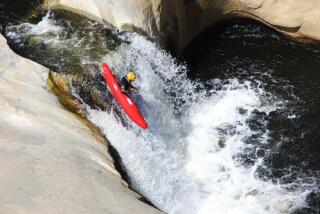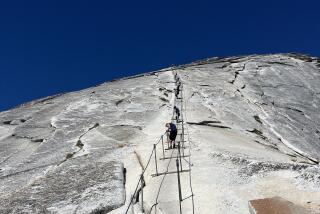On Mt. Rainier, a climb beyond expectations
- Share via
It was close to midnight when I could stand it no longer. Determined to stave off altitude sickness, I had downed six liters of water on the first leg of a climb of Mt. Rainier, drinking even when I wasn’t thirsty. Now nature was calling.
I fumbled in the darkness for my headlamp, switched it on, then pulled on the down jacket I was using for a pillow. Descending from my plywood sheet of a mattress, I slipped into my cold, damp climbing boots and, as quietly as possible, creaked over to the shelter door, doing my best not to wake the 15 others bunked in our hovel of a home. Lifting the beefy latch, I braced for a blast of wind, never noticing I was illuminating the ceiling.
“Dude,” whispered a more experienced adventurer, “your headlamp’s on upside down.”
I had to laugh. But I could afford to. The toughest part of my journey was over.
Not so for another first-time climber.
A football field away, across a boulder-strewn ridge and in a similarly spartan hut, rested one of the most powerful people in sports, NFL Commissioner Roger Goodell. He was lying in the dark but wide awake, dreading the final push to the 14,411-foot summit -- what he later would call the biggest “physical, emotional and probably mental” challenge of his life.
“Tod Leiweke made a good analogy,” Goodell said of the Seattle Seahawks’ chief executive who organized the climb. “He said it’s like Christmas Eve. I said, ‘Yeah, but one difference is you’re not getting presents.’
“You had nothing but bad thoughts. Things like avalanches, crevasses. . . . I’m thinking, ‘Hey, I’m not out here to kill myself.’ ”
Actually, Goodell, Leiweke, Seahawks Coach Jim Mora and a group of Pacific Northwest business leaders were making the trip for charity. They raised about $400,000 for the United Way of King County (Wash.) and put a spotlight on the NFL’s Play 60 program, designed to encourage children to get at least an hour of physical exercise a day.
I was allowed on part of the journey -- participating in training school, and meeting the group at base camp on the way up and accompanying them on the way down. The biggest challenge in that: the 4 1/2 -mile slog I made apart from the group from the trailhead in Paradise to the base camp at Camp Muir. The distance wasn’t the tough part; it was the grind of the nearly relentless incline -- a gain of about 1,000 feet in elevation for every mile.
At Camp Muir, elevation 10,080 feet, I met up with the rest of the climbing party, and we rested as best we could for a few hours in wood huts. Goodell’s group of 12, which included four guides, rose at 1:30 in the morning and -- equipped with headlamps, crampons, ice axes, and with ropes binding them in three groups of four -- made the push to the summit.
The guides included two of the world’s best climbers, Ed Viesturs and Peter Whittaker, co-owner of Rainier Mountaineering Inc.
Viesturs, who had recently climbed Mt. Everest, described my portion of the journey as a hike, whereas the trek from base camp to the summit is true mountain climbing.
It didn’t take long for Goodell to discover that. Within an hour of leaving Camp Muir, his path lit by just a small circle of light, he encountered his first crevasse.
Whittaker, who was about 20 feet ahead of him at the front of the rope, never hesitated in stepping over it and plodding on -- he grew up on Rainier and had climbed it 226 times. Startled, Goodell stopped at the edge and peered down at the pit of blue ice.
“It’s scary,” said Goodell, 50. “I’ve got to tell you, when you look down and literally you can’t see the bottom, and then they ask you to step over it, you say, ‘I don’t know about this. Let me think about this for a second.’ I hadn’t really focused much on that, and there’s a lot of [crevasses] out there.”
There were other perils too. Every so often, pieces of loose rock, many fist-sized or larger, broke loose from above and tumbled past the climbers. Then there was the surreal scenes, such as the woman Goodell’s group passed who apparently had given up on making the summit and plopped down dangerously close to a gaping crevasse.
“She was sitting there right on the edge because she had freaked out,” Goodell said. “Ed went over and tried to help.”
Goodell and the rest of the group reached the summit about 9 a.m. It was the second time Leiweke had gotten to the top, and the first time for the commissioner and Mora, who grew up in the shadow of the mountain.
Scaling Rainier isn’t climbing Mt. Everest -- according to the National Parks Service, roughly half of the 10,000 climbers who attempt to top Rainier each year reach the summit -- but it was a significant accomplishment for a first-timer such as Goodell, who spent months training for the trip.
Much of that training was done in the stairwells of New York skyscrapers, where he augmented his usual workout routine by lugging weights from floor to floor.
“I thought the training actually was pretty good,” he said. “I felt physically OK except when I was out of sync. In fact, because my technique was so bad, I labored and had to work harder.”
We all got a chance to work on our technique the day before the trek began, when Viesturs and Whittaker conducted “climbing school,” teaching us how to breath and walk up hills most efficiently, how to clomp around in crampons (spikes that are strapped to the bottom of boots) without impaling ourselves, how to work as roped-together units, and -- in the event we were to slip and go careening down the mountain -- how to use our ice axes to stop.
Most of these things were just fun practice for me, as the trip to base camp didn’t require ropes or crampons and wasn’t the slightest bit technical. It was, however, a long and exhausting hike, especially hauling my overstuffed pack, which included a tent that I didn’t even use.
The most difficult part of the trip from Paradise to Camp Muir is crossing the 2.2-mile Muir Snowfield, which is like legging up a seemingly endless ski slope. Backpacker magazine counts that featureless stretch among the 10 most dangerous hikes in the country, mostly because foul weather can roll in quickly and it’s easy to stray from the trail of boot tracks. Last year, a hiker on his way to Muir got lost on the snowfield and died of hypothermia.
Conditions for our adventure were less than ideal. After several days of sunshine, the clouds rolled in and the hike was a misty one. Because I wasn’t part of the 12-member main party, how I got to base camp was up to me. Fortunately, I had Seahawks photographer Corky Trewin and his brother, Chris, both experienced outdoorsmen, to show the way -- and to motivate me by counting steps through the most demanding parts. (“Eighty more steps and you can rest!”)
It took us about five hours to reach the rugged base camp, a collection of tent sites, huts made of either stone or plywood, and a cluster of outhouses best avoided. Climbers spend much of their time mining clean snow from pits they have dug, filling large trash bags with it, then dragging them back to melt for fresh water. Staying hydrated is key.
The generosity and fellowship of climbers is something to behold. At base camp, my new friends offered me food, water and tips on how to avoid altitude sickness.
“It doesn’t matter who you are, what gender, how much money you make, what power you have, everybody’s the same on this mountain,” said Viesturs, the first American to climb the world’s 14 highest peaks, all without the use of bottled oxygen. “And that’s really cool to put people together of different capacities on these ropes and have them work together as a team.”
A former Rainier guide who has been to the top 203 times, Viesturs said the climb is “pretty life-changing” for first-timers.
“Because a lot of people, even though they’ve trained hard or do other activities and other sports, for them this will probably be one of the hardest things they’ve ever done physically,” he said. “And they will have to dig deep and suffer a little bit, but it’s going to be an amazing experience.
“When they get down, I’ve had people say, ‘You’ve changed my life. I look at challenges differently now, because I saw what I was able to do.’ ”
For Goodell, who is heading into what could be the most turbulent part of his tenure as commissioner, negotiations with the players’ union over a new labor agreement, there were clear parallels between the climb and his day job.
“It’s taking on a challenge in sometimes uncharted waters,” he said. “You don’t know what to expect. You prepare for it as best you can, and then you just have to perform. And that’s what it was. It was more than I expected. You have to overcome your own self-doubt. It’s fear, man. Serious fear.”
Goodell said that, although he might not climb another mountain, he has immeasurable respect for those who do. I second that, and was feeling good about conquering the challenging trek to base camp and back.
A day later, I returned to Los Angeles, my thighs still aching and shoulders still throbbing from carrying a 40-pound pack for hours on end. All that sweating, panting and hoisting, but now the payoff.
I took a deep breath and made the most anticipated step of the journey -- onto the bathroom scale.
I can’t believe I gained four pounds.
--
More to Read
Sign up for The Wild
We’ll help you find the best places to hike, bike and run, as well as the perfect silent spots for meditation and yoga.
You may occasionally receive promotional content from the Los Angeles Times.







